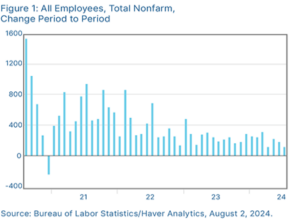Market Update—Month Ending August 31, 2024
Posted September 5, 2024
Quick Hits
- Solid Month for Stocks
Stock returns were positive in August despite an early month sell-off. - Bonds Continue to Rise
Falling interest rates led to positive bond returns for the fourth consecutive month. - Interest Rate Cuts Ahead
Investor expectations for rate cuts rose during the month. - Continued Economic Growth
Economic updates released during the month showed signs of continued growth. - Risks to Monitor
Markets face a variety of risks as we finish the third quarter. - Positive Outlook for Markets and the Economy
Markets and the economy set for continued growth in the months ahead
Solid Month for Stocks
August was an encouraging month for stocks, as markets ended the month in positive territory despite a brief sell-off at the start of the month. The S&P 500 gained 2.43 percent while the Dow Jones Industrial Average managed a 2.03 percent return. The technology-heavy Nasdaq Composite index lagged its peers but ended the month up 0.74 percent.
These solid results coincided with improving fundamentals. Per Bloomberg Intelligence, as of August 29 with 99 percent of companies having reported earnings, the average earnings growth rate for the S&P 500 in the second quarter was 13.97 percent. This is well above analyst estimates at the start of earnings season for an 8.34 percent increase and highlights the continued health of company fundamentals. Over the long run, fundamentals drive market performance, so the better-than-expected earnings growth is a positive development for investors.
Technical factors were supportive as well during the month. All three major U.S. indices spent the entire period well above their respective 200-day moving averages. (The 200-day moving average is a widely followed technical indicator, as sustained breaks above or below this level can signal shifting investor sentiment for an index.) The continued technical support in August was another encouraging development for investors during the month.
The story was similar for international stocks as well. The MSCI EAFE index gained 3.25 percent for the month while the MSCI Emerging Markets index was up 1.65 percent. Both of these international indices also spent the entire month well above their respective 200-day moving averages.
Bonds Continue to Rise
It was another solid month for fixed income investors, as falling interest rates led to rising bond prices. The 10-year Treasury yield fell from 4.09 percent at the start of August to 3.91 percent by month-end. The Bloomberg U.S. Aggregate Bond index was up 1.65 percent during the month.
High-yield bonds also had a positive August, as the Bloomberg U.S. Corporate High Yield index gained 1.44 percent. High-yield spreads spiked at the start of the month, hitting a 2024 high of nearly 4 percent, before falling to end the month at 3.15 percent.
Interest Rate Cuts Ahead
The falling rates in August was primarily due to rising investor expectations for interest rate cuts at the upcoming Federal Reserve meetings in September, November, and December. We entered the month with futures markets pricing in three 25 basis point interest rate cuts through the end of the year; however by month-end, these forecasts had increased to four cuts. Fed chair Jerome Powell announced at the annual Jackson Hole central bank retreat that the time has now come for lower interest rates, which was widely expected by economists and welcomed by markets.
This announcement near month-end helped drive the rising calls for rate cuts at the upcoming Fed meetings. While it’s too early to rely on cuts at the November and December meetings, a rate cut in September now appears to be locked in given the recent updates that we’ve seen on inflation and employment.
Speaking of employment, as you can see in Figure 1, the pace of hiring has slowed over the past few months, with July’s 114,000 job additions coming in well below economist estimates. Given the progress that we’ve seen in getting inflation back down near the Fed’s 2 percent target, employment data will be a key factor when the central bankers set monetary policy in the months ahead.

The Takeaway
- Market expectations for rate cuts increased during the month.
- Slowing hiring in July could be a sign of potential weakness for the labor market.
Continued Economic Growth
The economic data releases in August showed signs of continued economic growth. The revised second-quarter GDP report showed that the annualized pace of economic growth rose from 1.4 percent in the first quarter to 3.0 percent in the second quarter, up from advanced estimates for a more modest 2.8 percent growth rate. This result was well above economist estimates and was driven by higher personal consumption growth, which was revised up from an annualized rate of 2.3 percent to 2.8 percent in the second quarter.
Consumer spending remained robust in July, as personal spending and retail sales growth both accelerated during the month. The 1 percent rise in headline retail sales in July was especially encouraging following a downwardly revised 0.2 percent drop in sales in June and signaled continued consumer demand. A rebound in auto sales in July brought the pace of overall sales to its fastest level in more than a year, highlighting the impressive resilience for consumer spending in July. Given the importance of consumer spending on the overall economy, these updates were certainly welcome developments.
Business spending also showed signs of improvement during the month, as durable goods orders surged by 9.9 percent in July. While this was primarily due to a notable rise in volatile non-defense aircraft orders, the rebound in sales was still well above economist estimates and a good sign for overall business spending.
The Takeaway
- August’s economic data releases showed signs of continued economic growth.
- GDP growth accelerated in the second quarter.
- Consumer and business spending rebounded in July.
Risks to Monitor
While inflation has improved in recent months, it still remains a pressing risk for markets and the economy. Additionally, given the recent slowdown in hiring and the Fed’s dual mandate to promote stable prices and maximum employment, the job market is increasingly becoming a risk for markets. The rising expectations for rate cuts in August were largely due to expectations for a slowing economy ahead, especially for jobs and inflation. While lower inflation and slower hiring are expected in the months ahead, these results are not guaranteed, and surprises to this outlook could rattle markets.
August also highlighted the large level of political uncertainty that we face here in the U.S. This uncertainty is expected to increase as we approach the elections in November.
International risks remain as well, as seen by the expanding conflicts in Ukraine and the Middle East as well as the continued economic slowdown in China. While the direct market impact of these international risks has been limited so far, there is a lot going on internationally that we should be paying attention to.
The Takeaway
- Inflation and the jobs market remain the primary domestic risks for markets.
- Election-related uncertainty is expected to pick up as we approach the November elections.
- International risks could also negatively impact markets.
Positive Outlook for Markets and the Economy
While there are certainly real risks that investors should be aware of, on the whole, we remain in a good place as we finish off the summer and head into the fall. Markets have shown impressive resilience throughout the year and the economic backdrop remains solid. Market fundamentals show continued signs of healthy growth, which is a good sign for long-term investors.
Interest rates have often served as a headwind for investors over the past few years; however, Powell’s announcement at Jackson Hole indicates that it may be time for this headwind to transition into a tailwind. While we may certainly face short-term setbacks along the way, the most likely path forward for the economy and markets is further growth and appreciation ahead. Given the potential for setbacks, a well-diversified portfolio that matches investor goals and timelines remains the best path forward for most. If concerns remain, you should speak to your financial advisor to go over your financial plans.
Disclosure: This material is intended for informational/educational purposes only and should not be construed as investment advice, a solicitation, or a recommendation to buy or sell any security or investment product. Please contact your financial professional for more information specific to your situation.
Certain sections of this commentary contain forward-looking statements based on our reasonable expectations, estimates, projections, and assumptions. Forward-looking statements are not guarantees of future performance and involve certain risks and uncertainties, which are difficult to predict. Past performance is not indicative of future results. Diversification does not assure a profit or protect against loss in declining markets. All indices are unmanaged and investors cannot invest directly into an index. The Dow Jones Industrial Average is a price-weighted average of 30 actively traded blue-chip stocks. The S&P 500 Index is a broad-based measurement of changes in stock market conditions based on the average performance of 500 widely held common stocks. The Nasdaq Composite Index measures the performance of all issues listed in the Nasdaq Stock Market, except for rights, warrants, units, and convertible debentures. The MSCI EAFE Index is a float-adjusted market capitalization index designed to measure developed market equity performance, excluding the U.S. and Canada. The MSCI Emerging Markets Index is a market capitalization-weighted index composed of companies representative of the market structure of 26 emerging market countries in Europe, Latin America, and the Pacific Basin. It excludes closed markets and those shares in otherwise free markets that are not purchasable by foreigners. The Bloomberg Aggregate Bond Index is an unmanaged market value-weighted index representing securities that are SEC-registered, taxable, and dollar-denominated. It covers the U.S. investment-grade fixed-rate bond market, with index components for a combination of the Bloomberg government and corporate securities, mortgage-backed pass-through securities, and asset-backed securities. The Bloomberg U.S. Corporate High Yield Index covers the USD-denominated, non-investment-grade, fixed-rate, taxable corporate bond market. Securities are classified as high-yield if the middle rating of Moody’s, Fitch, and S&P is Ba1/BB+/BB+ or below.
Authored by Brad McMillan, CFA®, managing principal, chief investment officer, and Sam Millette, director, fixed income, at Commonwealth Financial Network®.
© 2024 Commonwealth Financial Network

